Schindler: e-procurement for components and transport
Schindler is a worldwide market-leading provider of elevators and escalators. The operative optimisation of processes plays an important part in ensuring their competitiveness. For more than five years the procurement organisation has taken advantage of information technology to create efficient processes beyond the company’s boundaries. Thanks to the consistent implementation of largely global, standardised processes the company has achieved a high level of e-procurement maturity. In 2008, Schindler expanded its electronic order system for elevator components to include the corresponding transport orders, with the aim of delivering installation components on schedule and complete to the building site. Thus the previously used logistics tool, which had been developed in-house, could be replaced and the monitoring of the logistics processes was improved. The IT service provider SupplyOn facilitates the largely automated, electronic communication flow between the involved parties.
Inhaltsverzeichnis
1. The companySupplier Relationship Management, Procurement, Purchase-to-Pay
2. The reason for the project
E-Procurement
3. Purchase-to-pay processes for components and transport
E-Invoicing, WebEDI, Organisation view and targets , Process view, Application view
4. Course of the project and operation
Evaluation, creation and roll-out
5. Experiences
Reflections
6. Success factors
1. The company
Background, industry sector, product and target audience
Schindler is a globally leading mobility provider and transports 900 million people every day with its elevators and escalators.
Established in 1874 in Switzerland, the Schindler group employs 45,063 people worldwide (end of 2008) and consists of two core areas: ‘Elevators & Escalators’ with a sales share of 62% and 43,226 employees in 2008; and ‘ALSO’, a market-leading wholesale and logistics consortium in Europe dealing in information and communication technology as well as entertainment electronics. As of the end of 2008, the families Schindler and Bonnard, and persons affiliated with the families, owned voting rights amounting to 70.5% of the capital shares recorded in the trade register.
As a market-leading provider of escalators and second largest manufacturer of elevators worldwide, the company is represented on every continent, counting more than 1,000 branches in 140 countries. In 2008, the company generated a turnover of 8,761 Million CHF, with an EBIT of 10,2%. Products range from affordable elevators for smaller residential dwellings to ambitious access and transport concepts for skyscrapers. The solutions stand out for their user-friendly and environmentally friendly technologies. For new systems, the main target audience are architects and general contractors, whereas for existing installations, the target audience are facility management companies and building proprietors.
Corporate Strategy
To maintain the position of market leader, the company’s competitive edge has to be redefined on a regular basis. Therefore processes are being continually optimised. Furthermore, the vertical range of manufacture is lowered by concentrating purely on strategic core competencies and by reducing the number of product families to a manageable size. These changes form part of a cost leadership approach with the aim of improving the company’s competitive position in an increasingly price-sensitive market. At the same time, the company engages in ongoing development of technologically advanced products.
Through its global presence the company is able to take advantage of the different global growth cycles and even out currency risks as well as economic fluctuations in the construction industry. Schindler’s mission statement is ‘Leadership through Service’, because immaculate performance throughout the approximately 30-year lifespan of its equipment is absolutely crucial. For this reason, the company offers a dense global and customer-oriented service network.
Procurement situation
Procurement is organised as a global network of product group and country teams, led by Corporate Purchasing unit. These teams work closely together to create a coherent and efficient procurement process.
In order to successfully implement strategies for component and system procurement, Schindler relies on long-term win-win-partnerships with its suppliers and strives for the continuous improvement of the entire supply chain.
Corporate Purchasing focuses on the following six strategic principles:
- Extensive demand pooling and consolidation of expenditures
- Development of key suppliers and sourcing from countries with the most attractive conditions
- Regular negotiation with suppliers including definition of target rates
- Supporting innovation by including suppliers in the development process
- Consistent implementation of the make-or-buy strategy
- Optimizing methods and tools throughout the entire supply chain
These principles are aimed at ensuring that Corporate Purchasing substantially contributes to Schindler’s competing power.
The procurement volume of the core area "Elevators and Escalators" amounted to several billion CHF in 2008.
Significance of IT and e-business in procurement
The Corporate Purchasing unit regards information technology as an essential element in enforcing procurement targets. Procurement is oriented along the following strategic principles:
- The purchase-to-pay process should be optimised through the use of electronic media to increase efficiency, reduce processing times und improve data quality.
- A cost-efficient data interchange platform that reflects the latest standards in technology should be established.
- A foundation that allows for a closer integration of external suppliers into Schindler’s supply chain should be created.
Schindler’s electronic procurement is based on three corner stones:
e sourcing, e ordering und the electronic purchase-to-pay process (ePtP). The latter will be dealt with in detail in this case study. For this reason only a short explanation of the first two will be given at this point.
E-sourcing
Schindler consistently uses e-sourcing tools such as electronic tenders (eRFx) and online reverse auctions (cf. Tanner/Perruchoud 2002) to identify and negotiate with suppliers. This creates a standardised, efficient and transparent sourcing process, allowing Schindler to make better use of market competition. Between 85-90% of the strategic procurement volume is negotiated electronically. In 2008, over 1,000 eRFX and around 200 online auctions were conducted. The e-sourcing platform, called eBreviate, is run by an IT service provider and is obtained by Schindler as a service.
E-ordering
For decentralised orders of indirect goods, Schindler uses SAP SRM 6.0. Employees use a web-based ordering application to choose goods from an electronic multi-vendor catalogue and add them to their shopping basket. Depending on the value of the goods, the order has to be authorised by a superior. From the shopping basket, purchase orders are then created in SAP MM and sent to the corresponding suppliers. Partners who are linked in via SupplyOn receive the orders in electronic form. Schindler strives to handle the entire data interchange electronically, from the initial order all the way through to invoicing. The catalogue is run by IT service provider jCatalog and is integrated in SAP SRM with the PunchOut method via the OCI interface. Suppliers deliver their product data in electronic format to jCatalog. Catalogues of specific suppliers, whose assortments are volatile or extensive or whose products are configurable, are directly integrated into SAP SRM also via the PunchOut method.
The e-ordering solution allows Schindler to follow well-defined, efficient order processes and place orders within negotiated contracts, which translates into significant cost savings for the company.
2. The reason for the project
Starting position and trigger for the project
Since 2006 Schindler has been using a central data interchange platform, run by IT service provider SupplyOn, to electronically exchange data with suppliers in a structured way, from initial ordering through to invoicing. In 2007, the company planned to incorporate its logistics processes into the same platform as the next logical step of their e-procurement strategy. This was to replace their existing logistics application that had been developed in-house. The application had been based on Schindler-specific units and rules, which had to be applied by logistics partners when organising transport for Schindler. In 2008, project SLOPE (Schindler Logistic Order Processing Elevators) was started to replace this existing logistics tool and to integrate the logistics service provider in the information flow with the suppliers of elevator components. This case study deals with the rollout of the new solution in Europe.
Introduction of the business partners
Logistics service provider (Carrier)
Schindler works with four so-called Elevator Consolidation Hubs in Europe. These are situated in Zaragoza (Spain), Milan (Italy), Mulhouse (France) and Herentals (Belgium) and are run by three logistics service providers. Components that have been picked up from the supplier are temporarily stored in these hubs until they can be delivered – complete and to the nearest hour – to the building site for assembly.
IT service provider for data interchange
SupplyOn is a service provider that integrates and standardises the processes between procurement organisations and suppliers in the automotive and manufacturing industry. The company was founded in 2000 as a co-operation of internationally active automotive suppliers and today offers a central platform for the interchange of business documents. SupplyOn’s headquarter is based in Munich with further branches in Shanghai (China) and Detroit (USA).
Its services also include solutions for e-sourcing and quality and project management in the field of purchasing, research & development, logistics and finance.
SupplyOn generated a turnover of more than 20 million EUR in 2008. Over 75% of the top-100 automotive suppliers worldwide used SupplyOn when working with business partners. In 2008, SupplyOn facilitated 20,000 business connections between companies from 70 countries.
3. Purchase-to-pay processes for components and transport
Organisation view and targets
A customer order for an elevator is divided into approximately ten components (e.g. cabin, drive), which are either produced by key suppliers or in one of Schindler’s own component factories. The suppliers have to pack the components into transport units and must keep them ready for loading until their collection by the carrier. They are also responsible for loading them from the ramp into the lorry (Incoterm Free Carrier FCA incl. loading). The suppliers are expected to electronically support the processes from ordering through to invoicing (cf. case study Kaved [Leimstoll 2003]).
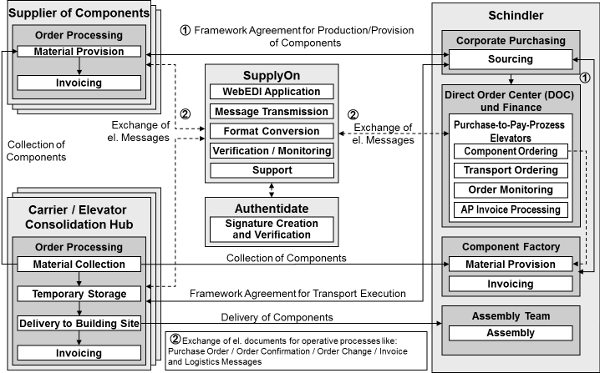
Figure 1: Business scenario showing all parties involved in the purchase-to-pay process
Schindler has outsourced its logistics to specialised logistics partners (carriers) (cf. Figure 1). The logistics partners pick up the components from the supplier or one of the components factories on behalf of Schindler and store them in the Elevation Consolidation Hub until they can be delivered in full to the building site. They are remunerated for the pick-up (inbound), the storage according to volume and weight of the transport units, and the delivery (outbound) according to loading metres. The carriers are expected to optimise costs for Schindler and to integrate in the electronic data interchange with the involved parties.
The IT service provider SupplyOn acts as a hub for the electronic data interchange (EDI) from ordering through to invoicing, including all relevant messages for the logistics processes. The advantage for Schindler is that only one interface has to be maintained for communicating with all its business partners. For this service SupplyOn charges a fee which is dependent on the number of connected suppliers and the number of different message types needed to support the processes (e.g. order, despatch advice, invoice). In turn suppliers and carriers benefit from the ability to communicate with other clients via the SupplyOn platform. Suppliers with small volume, insufficient IT infrastructure or missing EDI know-how have the opportunity to use the WebEDI solution via a browser. SupplyOn charges them modest fees: an initial registration fee as well as a monthly fee for operation, service and further development.
In order to deal with the complexities of the worldwide different legal requirements for electronic invoicing, SupplyOn has outsourced the signing and validation of electronic invoices to a specialised service provider (Authentidate). Schindler’s suppliers and carriers delegate invoicing to SupplyOn. For Schindler itself incoming e-invoices are being validated. These services are charged with a fee per signed document.
In Spain, Schindler runs the Direct Order Centre (DOC). This centre co-ordinates sales orders as well as the corresponding purchase orders and is the main contact for suppliers and carriers. The finance department deals with cases where the automated invoice reconciliation has failed.
Objectives
With project SLOPE, Schindler intended
- To develop a standardised interface between Schindler and its carriers, which allows for a simple and flexible integration of new carriers,
- To create a reliable and efficient supply chain process from the elevator order through to the delivery of the product on the building site,
- To define performance indicators and implement process monitoring and
- To establish the logistics process on standardised transport units.
Process view
This section describes the electronic message interchange in the integrated purchase-to-pay process between Schindler and its suppliers (cf. Figure 2).
At Schindler’s end, all messages are created or received electronically. The commission number is the central reference information for the order monitoring. All corresponding purchase orders can be allocated to this number. The transport order number plays a central role for the logistics monitoring. Schindler’s purchase order numbers with their relevant position numbers form the basis for the automated invoice control.
Order confirmation is regarded as the binding basis for delivery and invoicing. The goods receipt is booked when confirmation of availability to ship has been received from the carrier. Based on this data, the automated invoice reconciliation ensues.
In contrast to the replaced process, suppliers now have to report transport units to Schindler via an electronic despatch advice as soon as the components are ready for loading. The despatch advice must contain dimensions and weights of the packaged transport units. These units come with a packing list. A label has to be attached to each transport unit (see Figure 3) and must clearly display a unique barcode and reference information about the commission and the purchase order. WebEDI suppliers can print off the label from SupplyOn, EDI suppliers must create the label themselves according to Schindler’s specifications.
The carriers are informed about the individual component orders and the corresponding suppliers via a transport order from Schindler. Like Schindler, the carriers receive a confirmation from the supplier that the components are ready for loading, along with the despatch advice that shows the specific transport units. Once the units have been picked up from the supplier and have reached the Elevator Consolidation Hub, the carrier reports the goods receipt to Schindler. As soon as all the purchase orders of a commission are stored at the hub, the carrier sends a status report to confirm that the delivery batch is complete. From this point in time, the elevator can be delivered to the building site. When Schindler’s sales office enters the exact date and time of delivery into the sales order, a purchase order change is sent to the carrier who then delivers the elevator components to the building site. Once the delivery has been carried out, the carrier sends a delivery confirmation. Invoice reconciliation for carrier invoices is based on goods receipt messages (Inbound-Fee), the storage duration of the transport units at the Elevator Consolidation Hub (Hub-Fee) and the delivery confirmation (Outbound-Fee).
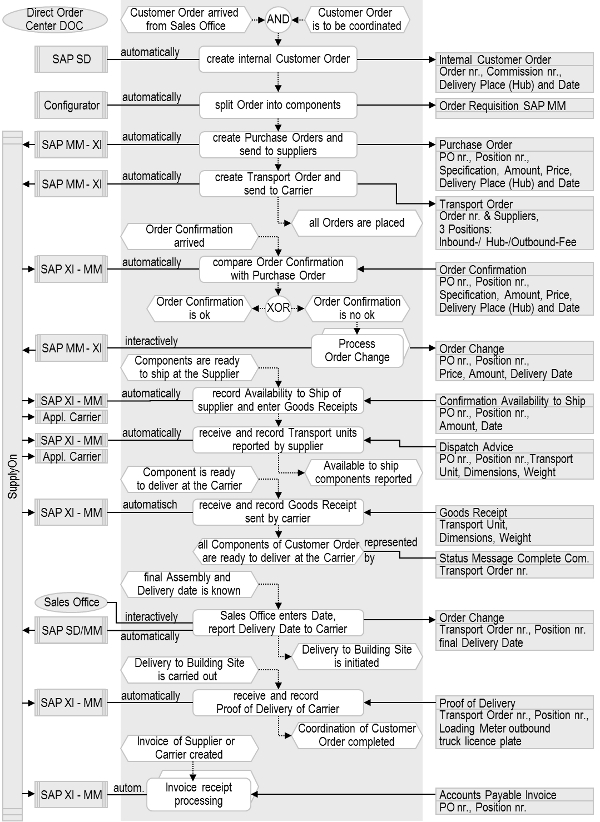
Figure 2: Integrated purchase-to-pay process for components und transport
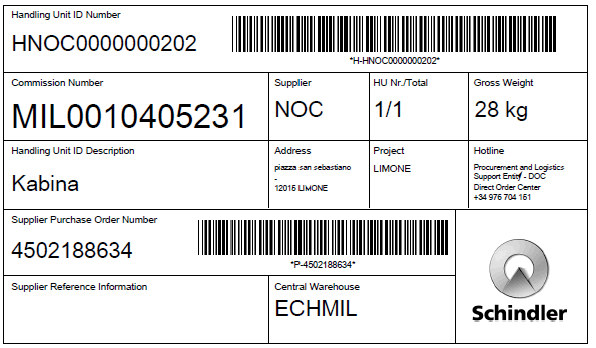
Figure 3: Example of a barcode label for a transport unit
Application view
Schindler’s ERP system is SAP Enterprise. Customer orders are created in the sales module SD. These orders are then broken down into purchase requisitions via a SAP-based configurator and the corresponding purchase orders are then created in the material management module MM. Sales orders are tracked in the SD module, while purchase orders are tracked in the MM module and logistics messages (warehouse administration and transport) in the LE module. The incoming electronic invoice is logically linked to the booking and is stored in the archive alongside the signature and the signature validation protocol. The communication interface used is SAP XI (Exchange Infrastructure). For the exchange of data Schindler uses SAP’s own format IDoc XML according to the defined message standards
(cf. Figure 4).
The IT service provider SupplyOn runs a WebEDI application, which suppliers can simply access through a web browser. With this tool, messages can be viewed and created. Data can also be uploaded and downloaded with a simple CSV file. The uploaded data is converted into an XML format and added to a database. To support the logistics process, the required transport documents and labels are provided for printing. SupplyOn uses Seeburger’s Business Integration Server for the data interchange. This server supports the validation, monitoring, conversion and exchange of messages. SupplyOn first converts the messages in UN/Edifact, before converting it into the format requested by the receiver. Other than UN/Edifact, the most common formats supported by SupplyOn are ANSI X.12 and VDA, which are widely used in the automotive sector. The IT service provider Authentidate, responsible for the signing and validation of electronic invoices, is also connected via the Business Integration Server.
With Schindler’s own component factories all messages are exchanged directly within SAP. Only logistics messages are sent via SupplyOn.
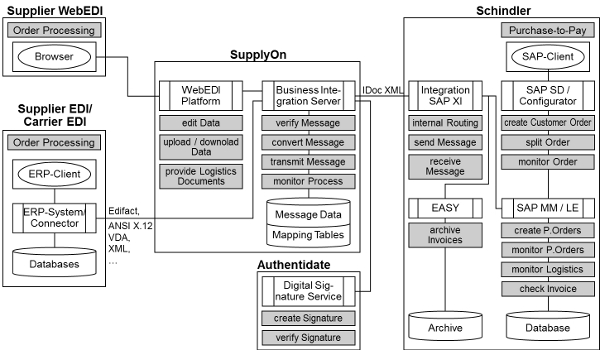
Figure 4: Application view of the purchase-to-pay process for components and transport
4. Course of the project and operation
Decision for investment
The deciding factors for the project were technological and commercial considerations. One reason was to finally replace Schindler’s own logistics tool after several attempts as the tool’s singularity limited Schindler’s flexibility to select carriers. A second reason was the risk of dependency, because one person only maintained the old tool. A business case was calculated for project SLOPE, which was given the green light at the end of 2007.
Project management und change management
Project SLOPE was managed by the logistics department of the unit Product Line Management. The interdisciplinary team further consisted of personnel from the purchasing and IT (SAP CC) departments as well from the Direct Order Centre, the most directly affected operative unit. Within SupplyOn, the project was managed by a consultant who was responsible for establishing the message specifications. He also co-ordinated the involvement of SupplyOn’s internal technical staff and the product management department. As for the carriers and suppliers, either the company’s own IT department or a representative of the external service provider was involved in the project, as well as sales personnel.
For the carriers, SLOPE meant the involvement in a larger integration project with Schindler. At the same time, carriers were aware that, thanks to the new solution, Schindler would be technologically more independent. As a result, it soon became apparent that not all carriers gave the project the expected level of priority. Schindler reacted by changing their original plan of switching all carriers to the new system simultaneously and allowed carriers to switch in a time frame more suitable to the individual companies. In addition, Schindler covered the registration and interface fees, which SupplyOn would have charged to the carriers.
The suppliers also had to be convinced about the new logistics process as the previously agreed message volume would increase and suppliers would have to deliver additional message types and data about the transport units.
Evaluation, creation and roll-out of the solution
Since 2006, Schindler had been using SupplyOn’s services for the electronic data interchange with suppliers and maintained a good working relationship. SLOPE intended the integrated interchange of logistics messages and so, during the concept stage in 2007, the existing IT partner was selected for the technical implementation of the project. Another reason for choosing SupplyOn was the congruence between their plans for further development and Schindlers’s functional and geographical requirements.
First, the new process had to be defined and specified in detail. Then, additional information for the existing electronic messages as well as new messages required for the logistics process could be derived. To ensure this new solution could be offered as a standard tool in other sectors as well, SupplyOn specifically appointed a group of experts to evaluate the solution.
The smooth running of the fully integrated logistics process requires the linking in of all key component suppliers who are geographically allocated to an Elevator Consolidation Hub. To achieve this, Schindler was able to use its existing supplier adoption process, which had already proved successful before the SLOPE project (see Figure 1.5). The process begins with a kick-off meeting. Then the supplier registers on the SupplyOn platform and enters into a contract with SupplyOn. This is followed by a test phase. Suppliers who choose the WebEDI solution are trained by Schindler. After a final acceptance test the necessary data assimilation and acquisition takes place. Finally, the process can go live.
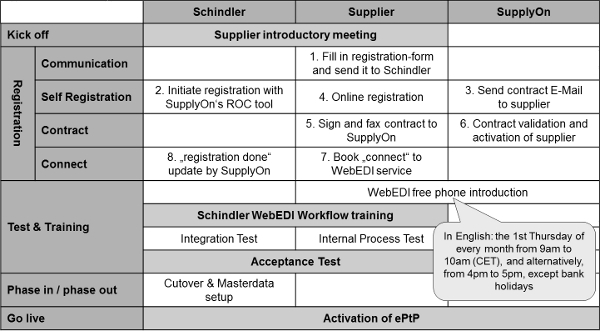
Figure 5: Schindler’s supplier adoption process to the WebEDI solution with SupplyOn
Once the new process has been implemented the carrier must keep the former logistics application running for approximately three to four months until any running orders are largely completed. As soon as only a few orders are still open, the remaining data will be migrated.
Once the rollout has been successfully completed for the carriers in Europe, the new process will be applied globally.
On-going maintenance
Schindler’s SAP Basis Support ensures that the interface with SupplyOn runs smoothly. In the event of message transmission problems, the support process is passed on to Schindler’s SAP Competence Centre. As the solution is based on otherwise standard components, no additional maintenance is necessary.
Schindler and SupplyOn have defined a standardised supplier adoption process (see Figure 5). SupplyOn is responsible for providing technical and administrative support to the suppliers for the solution described.
SupplyOn conducts a release change twice a year. Optimisations of general interest can be brought in through expert groups. For specific requirements, a change request must be submitted.
5. Experiences
User acceptance
Staff from the Direct Order Centres was involved from the start through a person in the project team. The new process meant almost only operative advantages to them and was quickly accepted. The team members also appreciate the enhanced transparency and the simplified co-ordination.
With some carriers and suppliers, it may still take some time before they fully recognize the advantages of standardisation and the benefits of using the application with further business partners.
SupplyOn strives to make work easier for WebEDI users by continually optimising the user-friendliness of the application. On top of functions for data uploads and downloads, users can also use generate reports and create user-specific views.
Targets achieved and changes accomplished
In terms of scope, the targets were reached, however, the rollout of the process to all carriers and suppliers took longer than expected. As of the middle of 2009, 90% of messages were exchanged within the required structure, 70% of suppliers were able to transmit messages to the logistics service providers and one of three carriers was connected SupplyOn. For the remainder, a plan has been defined that takes the partner’s capabilities into consideration and will be consistently implemented. The aim is to complete the integration of all Elevator Consolidation Hubs in Europe by the end of 2009. The message flow with connected partners is stable, so that the number of irregularities has settled at a low level. The solution is optimally embedded in the existing application architecture.
External project costs and internal costs within the IT and logistics units have been somewhat higher than expected due to the project delays.
Changes
With one carrier the former logistics tool was replaced after a transitional period of four months. This meant that the most important goal had been achieved.
The new solution eliminates manual co-ordinating activities. The new process is prompt, quicker, more efficient as well as more transparent and it features better data quality. It enables Schindler to monitor customer orders, purchase orders and transport orders with important key performance indicators such as on-time delivery and time duration at the hub. Aligning the logistics processes to transport units creates an increased cost transparency. The simplified charging model for transport and storage also allows for a pre-calculation of logistics costs. Based on that, further deadline and cost optimisation can be carried out.
Thanks to the replacement of Schindler-specific processes and the standardisation of messages, Schindler was also able to reduce its dependency on carriers. In turn, the carriers benefit from scalable processes and increased efficiency. At the same time, carriers can use the solution to access potential new clients and so expand their services.
6. Success factors
Specialties of the solution
The solution redesigns the logistics processes involving key suppliers and carriers and defines the transport unit as the new reference value, thereby creating a new, efficient and transparent process between all parties involved. Messages are exchanged in a well-structured electronic format facilitated by IT provider SupplyOn. This largely eradicates manual entries for Schindler. SupplyOn reduces complexities by enabling communication with all connected business partners via a central interface. While smaller suppliers can be integrated simply via WebEDI, a full integration eliminates costly media disruptions and manual activities.
Reflections on the factors for continued success
With SLOPE Schindler achieved to implement a further process into the existing IT architecture and to electronically integrate carriers as external partners into its processes. This fundamentally increases the productivity of the existing IT system.
The choice for using the same IT service provider for expanding electronic processes was based among others on a similar vision for the medium-term development of the solution – a good prerequisite for continued success. Both partners explicitly strive for standardisation and this has a positive effect on the rollout and therefore the efficiency and effectiveness of the solution.
In terms of successful b2b-relationships, it is suggested to choose IT service providers with a large, established network of partners. Furthermore, it is important to take your partners’ concerns seriously and so gain their support for the solution. Commitment and sustainable solutions that take the supplier's needs into account are also vital for the success.
Lessons Learned
Processes of change are often met with resistance and to reduce this resistance it is crucial to include the affected parties. However, the affected parties should only be guided as much as is absolutely necessary to encourage them to take ‘ownership’ of the solution as soon as possible.
It pays to define a detailed, interdisciplinary process in the early stages of the project. Throughout the duration of the project, this serves as a solid basis for the implementation without any significant changes and facilitates the later rollout with further business partners.
It is worthwhile applying established standards and to abide by them. This is of benefit to all partners involved as co-ordination efforts and costs can be reduced when compared to using individual solutions.
Standardisation based on experiences within the organisation is a promising approach to optimising processes that is met with acceptance by the affected parties.
Companies often underestimate change that results from a process alteration, paired with a new technological solution. In B2B integration projects it is therefore recommended that inexperienced companies should be offered a Web-EDI solution as a first step to familiarize themselves with EDI and the electronic processes involved.




